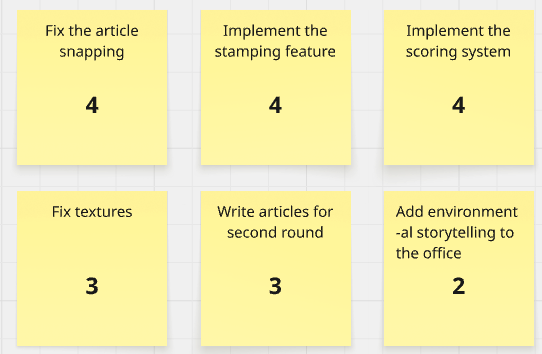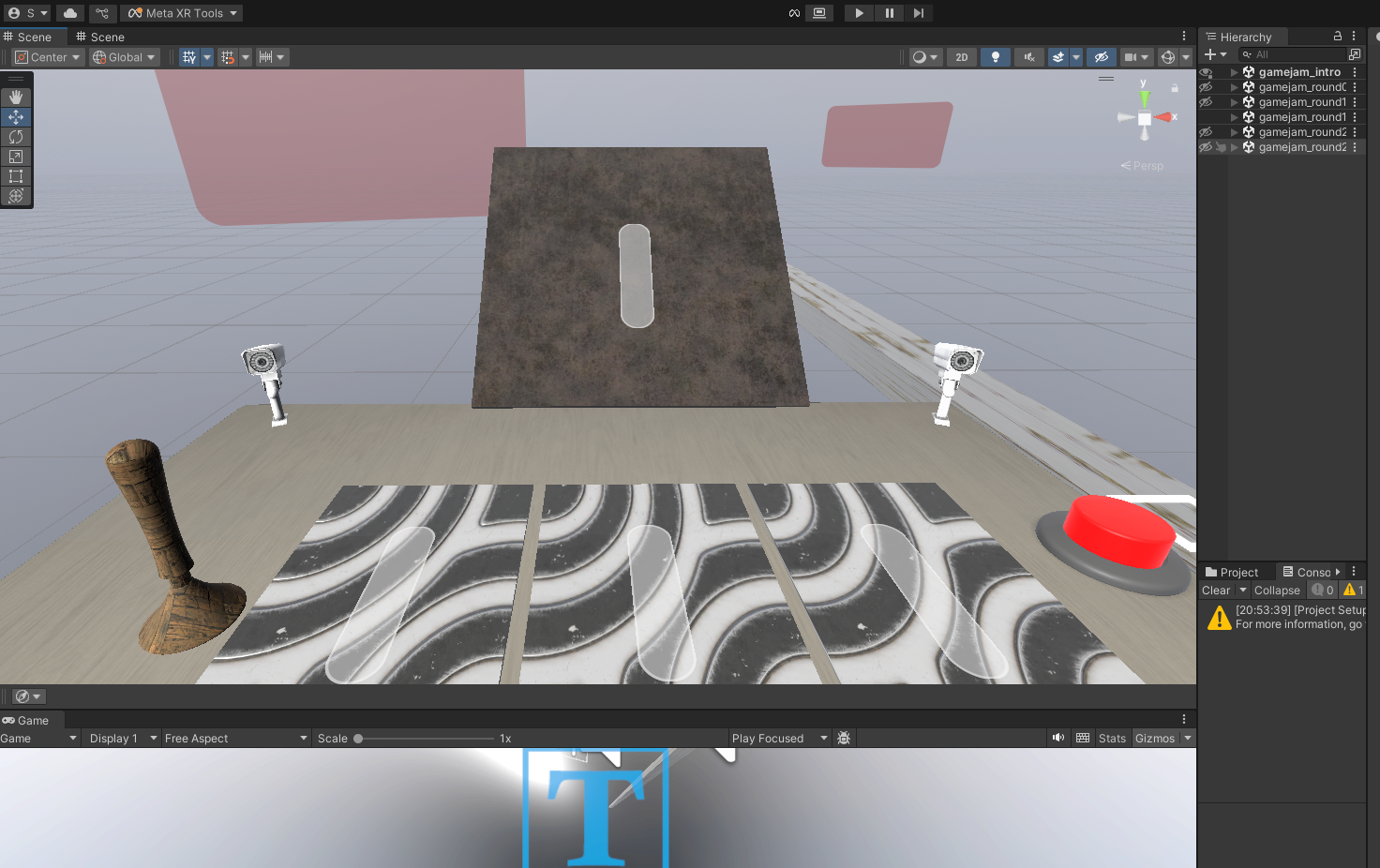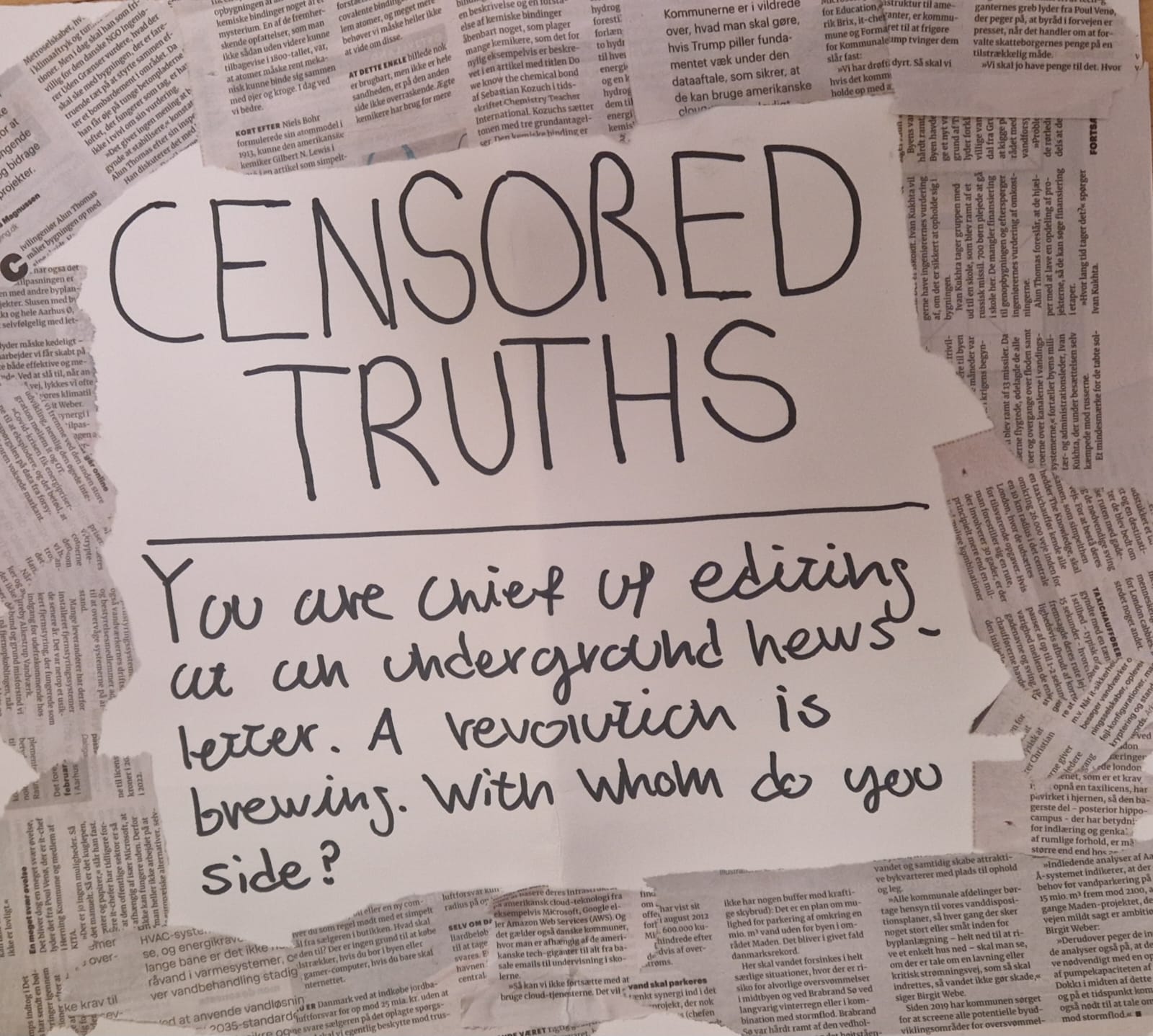Game Log 4 – Create
Process and Refinements – From Experience to Play
Create methods
During the CREATE phase, we focused on refining the game’s core mechanics and integrating meaningful interactions with the game objects. At the beginning of this phase, we used the Decision Board to prioritize our remaining tasks. We identified what we needed most to make the prototype work and reasonable, like fixing the article snapping, the scoring system of the article, putting (and changing old) textures, stamping features, and so on.

The Playable Prototype method guided our development: We turned our interactive AR mockup into a complete game loop. Everything was then included in the interactive mockup to test every component, while still highlighting the cultural values of our articles.
We also used Pitching tools to create a presentation for the EXPO, ensuring we communicated both the emotional tone and the ideological core of the game, following the European values of freedom. Our pitch helped consolidate the narrative and gameplay loop — especially since there are different mechanics to be aware of— in a concise format to attract the player interest and support them through the playtest.
Process Documentation
Our prototype evolved into a fully playable AR experience using the Meta Quest headset.
The key features that we worked on during this phase included:
- Article Snap System using SnapInteractables to organize articles on a virtual desk.
- Framing Mechanic: Articles offer two selectable framings, each affecting the scoring system. The final scores we configured are Trust in Establishment (establishment) and Revolutionary Sympathy (revolution).
- Visual Stamp System: Using a physical-like stamp (that you have to grab like a real one) the user prints a red “APPROVED” stamp, transforming the draft articles into a ready-to-mass-print newspaper.
- Scoring & Round System: After printing a newspaper, article effects are registered, and the round changes based on the resulting ideological alignment.
- Textures changes and new scene objects, i.e. surveillance cameras, to make the users feel constantly observed while doing their choices.
- Integration of some sound effects and transitions.

Technical Challenges
The core challenge was creating an intuitive grabbing system that aligned with the game's rigid mechanics and score system. We decided not to use head ray + pinches gestures, nor using the controllers with rays, but instead make the player use real life hand gestures customized for each object on the scene, for example the stamp needs to be grabbed with a closed palm grip to make the stamp action more satisfying and realistic, while papers on the table can be grabbed by gripping their edges with two fingers.
We had to make sure that, while having multiple grabbable objects, none of them interfered with each other and that all interactable elements on the desk remained organized and clearly visible to the player.
Particularly, papers could be picked up to be read, snapped out from their original place (returning to their place if the user left grip after a set timeout), snapped into the newspaper board, and stamped without interference between UI and grab events. We solved this through custom collision management, tagged layers, and prefab isolation.
The stamp needed to recognize only 3 articles inside the stamping box, and retrieving the number of snapped items in their parent object was not easy, as registering them as snapped required to make use of pre-existing Meta libraries, which needed to be modified. We dynamically retrieved snapped objects from their SnapInteractables class to calculate scores accurately.
Another issue we encountered was the timing of the events, which needed to be transformed into Coroutines. Fade transitions were hard to implement for timing, graphical effects and for the interaction between them and the game logic, which is where and when they have to be triggered.
EXPO Preparation
At the EXPO, we presented “Censored Truths”, a mixed-reality AR experience where the player steps into the role of a press officer under an authoritarian regime. During our presentation, we explained the core mechanics and principles of the game.
The player must read and evaluate fictional newspaper articles, and based on their preference choose how to frame them, stamp them for approval and send them to be printed. Each choice affects two ideological scores: Revolutionary Sympathy and Trust in Establishment, shaping the narrative story across game rounds.
We emphasized the ideology of the game: the core gameplay loop reflects on European values such as freedom of speech, critical citizenship, and rule of law. It ties directly to the EPIC-WE Game Jam theme, “Heritage Remixed,” as we explored before, by inviting players to reconsider how information, memory and cultural identity are determined by the rulers (governments, dictators, etc.) and how dissent can become a form of preserving or revealing the truth.
Our setup for the EXPO included:
- A physical stand with a Meta Quest station, where users could interact with the game
- A PC to watch a video of the gameplay beforehand: the short looping video core interactions like article selection, framing, stamping, and round transitions.
- A thematic title and hand-written plaque, which was made using newspaper to be in theme with the game and which includes the game intro, explaining the role of the user.
- A feedback zone where users got asked questions regarding the game.

EXPO Evaluation
At the EXPO, multiple users played the full game loop. Some players went in blind with no prior introduction or explanation, at their own request. Other players were given an introduction to the concept of the game and guided along. After playing, 7 of the players answered a questionairre with 6 questions regarding the various interactions, the story and the concept. Furthermore, a number of comments were noted down, and anecdotal observations were made during each playthrough

- Mechanics and interactions: For the majority of the participants, including the ones who were given no prior introduction to the game, the interaction techniques offered were immediately self evident. Many players reached for the stamp before any other game object, and immediately tried to stamp the articles or the newspaper draft box. Seeing that stamping an empty draft box with no articles offered no feedback, some participants understood that they needed to first include the articles, and others had to be given assistance. When grabbing and reading the stories laid out on the table, participants differed in the attention they paid to the stories. Some where more interested in reading each article thoroughly, while others appeared to merely glance at them, appearing more interested in the interactions than the content of the articles. Some players commented that the stories snapping back into place upon being let go was annoying, as it ment they had to hold up their arm for extended periods of time while reading, this can be easily improved by adjusting the timeout before each item snaps back to its position. While this mechanic exists to enforce the constraint that only one framing for each article can be selected at a time, it seemed to become another source of confusion. Many participants did not understand that the columns of the articles on the table represented different framings, and needed to have it explained that they had to pick one article from each column.
- Story and concept: Almost none of the participants made any remarks about the actual story or the characters present in the articles, but the story was nonetheless rated positively by most players on the questionairre. Many however showed great interest and appreciation for the general concept of the game, often citing Papers Please for comparison. One participant remarked that the concept presented a novel and unique medium for story telling.
From a technical perspective, all interactions remained stable, everything worked as it should have, except for the Quest bounderies, which needed to be recalibrated a few times, probably due to users moving around a lot. Switching from stationary boundaries to bigger ones made it work with any more issues. No critical bugs were encountered.
Get Censored Truths
Censored Truths
Game for the class "Advanced Augmented Reality Project", participating in the "EPIC-WE" Game Jam
| Status | Released |
| Authors | NoirQS, louisgkl, Marturiel |
| Genre | Educational |
More posts
- Game Log 3 - Imagine62 days ago
- Game Log 2 – Play86 days ago
- Game Log 1 – Experience92 days ago
Leave a comment
Log in with itch.io to leave a comment.